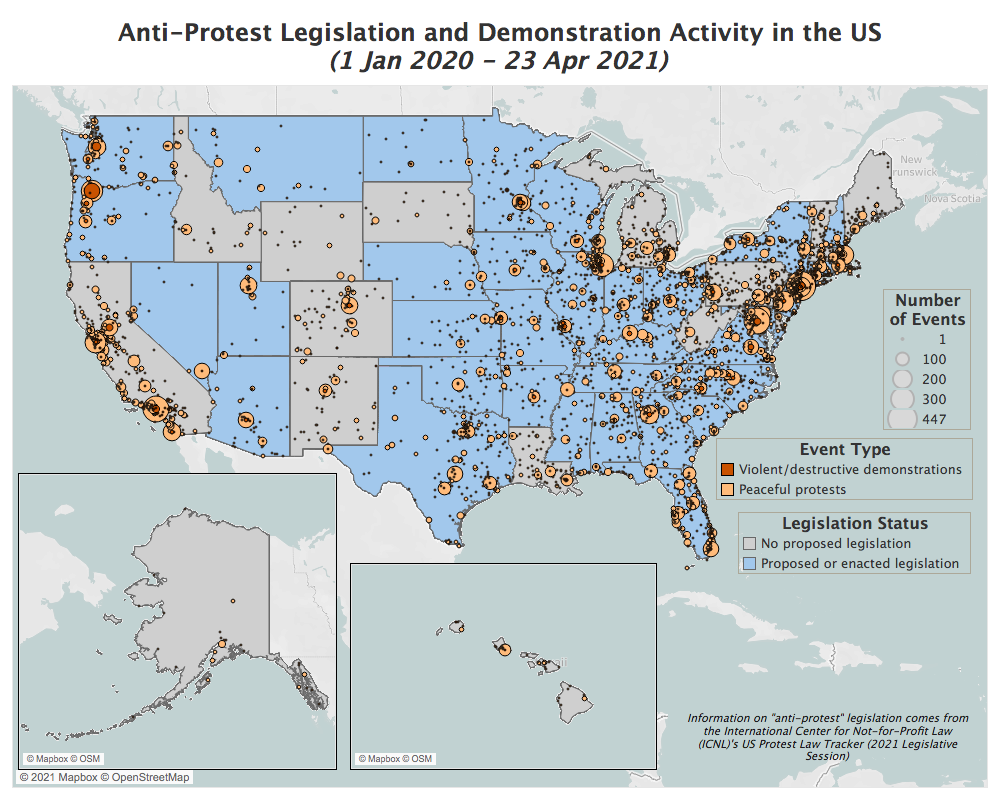Key Trends
- At least 34 states have introduced “anti-protest” bills to restrict demonstration activity or to expand legal protections for drivers who strike protesters with their vehicles
- Although the proposed legislation is purportedly meant to address violent riots, 97% of all demonstrations in these states have been peaceful — the same percentage recorded in states where no new legislation has been proposed
- Despite equal levels of peaceful protest activity, demonstrations in states pursuing new legislation already face higher levels of police intervention and force relative to other states
- At the same time, these states have also seen higher rates of demonstrations related to the Black Lives Matter (BLM) movement, raising concern that this legislative push is actually aimed at suppressing racial justice activism
Overview
Since the wave of demonstrations over the police killing of George Floyd in May 2020, state governments have proposed more than 90 “anti-protest” bills to restrict demonstration activity around the country (Al Jazeera, 22 April 2021). Republican lawmakers have introduced 81 bills in 34 states during the 2021 legislative session alone, more than double the number introduced in any other year, according to the International Center for Not-for-Profit Law (New York Times, 21 April 2021; International Center for Not-for-Profit Law, 22 April 2021). These bills have become law in states like Oklahoma and Florida, with new legislation increasing the penalties for “unlawful protesting” and “granting immunity to drivers whose vehicles strike and injure protesters in public streets” (New York Times, 21 April 2021).
Although officials have cited instances of protest violence over the past year to justify this new legislative push — with Governor Ron DeSantis labelling Florida’s law “the strongest anti-looting, anti-rioting, pro-law-enforcement piece of legislation in the country” (New York Times, 21 April 2021) — most of these states have experienced low levels of violent or destructive demonstration activity. ACLED data show that, on average, the states in which strict “anti-protest” laws have been proposed are home to the same rate of peaceful protests — 97% of all events — as states that have not pursued such legislation, meaning that violent demonstrations do not feature more prominently in the former than the latter. States like Florida and Oklahoma, which have promulgated some of the most restrictive new laws, have actually seen a lower proportion of demonstrations involving violent or destructive activity than most other states in the country.
These 34 states are home, however, to a higher percentage of demonstrations associated with the BLM movement. In the states that have introduced or enacted “anti-protest” legislation, 43% of all demonstrations recorded since the start of last year have been related to the BLM movement, relative to 37% in the states that have not. Police have also taken a more heavy-handed approach to protests in these states: since the start of last year, authorities have engaged in at least 6% of all demonstrations in the states that have pursued new laws, relative to 5% in other states, and they have used force in 3%, compared to 2% in other states. Civil rights advocates argue that “laws are already in the books to stave off riots” (Business Insider, 21 April 2021), and the higher rates of police intervention and force in these states, despite equal levels of peaceful demonstration activity when compared to the rest of the country, suggest that authorities are already aggressively enforcing existing legislation. These trends have raised concerns among activists that the true purpose of this new legislative push is to “silence dissent” and foster “a culture of impunity among protest opponents” (ACLU, 19 April 2021; Intercept, 21 January 2021).

A US-based 501(c)(3) non-profit organization established in 2014, ACLED is the highest quality and most widely used real-time data and analysis source on political violence and demonstrations around the world.
If you would like to use ACLED data and analysis, please review our Terms of Use & Attribution Policy. For more information about ACLED methodology, please check our Resource Library.
For interview requests and press inquiries, please contact: Sam Jones, ACLED Senior Communications Manager




